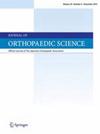关节镜下肩袖修复术后肩锁关节的骨髓水肿
IF 1.5
4区 医学
Q3 ORTHOPEDICS
引用次数: 0
摘要
背景肩锁关节(ACj)骨髓水肿(BME)可能发生在关节镜下肩袖修复术(ARCR)之后,导致术后肩锁关节持续疼痛。我们对 ARCR 术后 ACj BME 的发生率和临床特征进行了研究。方法纳入的患者在 ARCR 术前表现出 ACj 相关症状,MRI 检查未发现 ACj BME,术后 2 年能够接受 ACj 的物理和 MRI 检查。排除了接受锁骨远端切除术或ACj下方骨质增生切除术的患者,以及无法实现肩袖初级修复的患者。术前以及术后3、6、12和24个月时进行核磁共振成像评估。术后24个月时,脂肪抑制T2核磁共振成像显示ACj有BME的患者被分为BME+组,没有BME的患者被分为BME-组。我们对各组患者的背景、手术时间、日本骨科协会(JOA)评分、再撕裂率、ACj压痛和跨体外展试验进行了比较。此外,我们还研究了 BME 的发生时间。研究期间共进行了 345 次 ARCR,排除了 114 个肩关节后,将其余 231 个肩关节纳入研究范围。BME-组有208例,BME+组有23例。BME 发生率为 9.96%。虽然两组患者术后的 JOA 评分均比术前有明显改善,但两组之间并无显著差异。就再次撕裂而言,BME+组有1例,BME-组有7例。BME + 组的 ACj 压痛阳性率和跨体外展试验阳性率明显更高(P < 0.001)。术后3个月出现BME的有6例,6个月有9例,1年有8例。没有一名患者在术后 1 年以上出现 BME。结论 ARCR 术后 ACj 中 BME 的发生率为 9.96%。有BME的患者更容易出现ACj压痛和跨体外展试验阳性。ACj BME通常发生在中小型肩袖撕裂的ARCR术后6个月至1年内,这表明BME与术后肩关节功能改善有关。应将 ACj 视为中小型肩袖撕裂 ARCR 术后持续疼痛的潜在部位。本文章由计算机程序翻译,如有差异,请以英文原文为准。
Bone marrow edema in the acromioclavicular joint after arthroscopic rotator cuff repair
Background
Bone marrow edema (BME) in the acromioclavicular joint (ACj) may occur after arthroscopic rotator cuff repair (ARCR), resulting in persistent postoperative ACj pain. We investigated the incidence and clinical characteristics of BME in ACj after ARCR.
Methods
Patients exhibiting ACj-related symptoms prior to ARCR surgery, no BME in the ACj on MRI, and an ability to undergo 2-year postoperative physical and MRI examinations of the ACj were included. Patients who underwent distal clavicle resection or osteophyte resection below the ACj and those unable to achieve primary repair of the rotator cuff were excluded. MRI evaluation was performed preoperatively and at 3, 6, 12, and 24 months postoperatively. Patients who showed BME in ACj on fat-suppressed T2 MRI at 24 months postoperatively were classified into the BME + group, and those with no BME were classified into the BME− group. Patient background, operation time, Japanese Orthopedic Association (JOA) score, re-tear rate, ACj tenderness, and cross-body adduction test were compared between groups. In addition, we examined the time of occurrence of BME.
Results
A total of 345 ARCRs were performed during the study period. After the exclusion of 114 shoulders, the remaining 231 shoulders were included in this study. There were 208 cases in the BME− group and 23 cases in the BME + group. The incidence of BME was 9.96 %. Although the JOA scores of both groups showed a significant improvement postoperatively compared to preoperatively, there was no significant difference between the two groups. In terms of re-tear, there was 1 case in the BME + group and 7 in the BME− group. Positive ACj tenderness and cross-body adduction test were significantly higher in the BME + group (P < 0.001). BME occurred in 6 cases at 3 months, 9 cases at 6 months, and 8 cases at 1 year postoperatively. None of the patients developed BME at more than 1 year postoperatively. BME was observed on MRI in all cases at 2 years postoperatively.
Conclusions
The rate of occurrence of BME in the ACj after ARCR was 9.96 %. Patients with BME were significantly more likely to have ACj tenderness and positive cross-body adduction test. BME in the ACj often occurs within 6 months to 1 year after ARCR of small-to-medium rotator cuff tears, suggesting a relationship with postoperative functional improvement of the shoulder joint. The ACj should be considered as a potential site of persistent pain after ARCR for small-to-medium rotator cuff tears.
求助全文
通过发布文献求助,成功后即可免费获取论文全文。
去求助
来源期刊

Journal of Orthopaedic Science
医学-整形外科
CiteScore
3.00
自引率
0.00%
发文量
290
审稿时长
90 days
期刊介绍:
The Journal of Orthopaedic Science is the official peer-reviewed journal of the Japanese Orthopaedic Association. The journal publishes the latest researches and topical debates in all fields of clinical and experimental orthopaedics, including musculoskeletal medicine, sports medicine, locomotive syndrome, trauma, paediatrics, oncology and biomaterials, as well as basic researches.
 求助内容:
求助内容: 应助结果提醒方式:
应助结果提醒方式:


